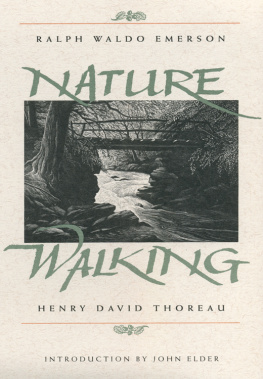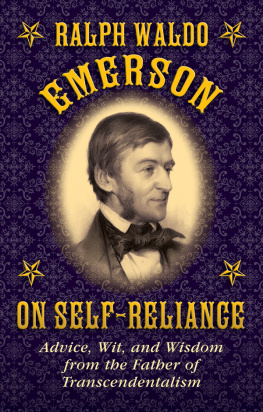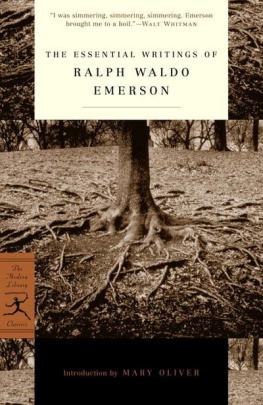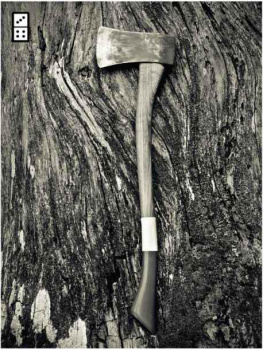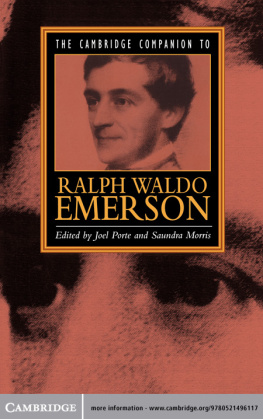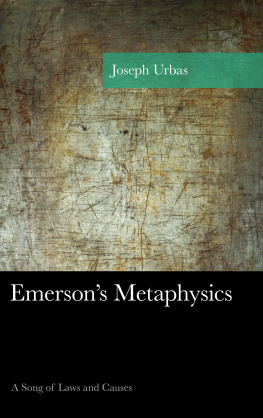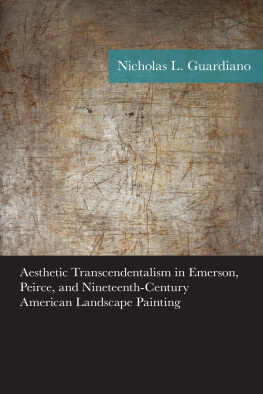Ralph Waldo Emerson - Nature and Walking
Here you can read online Ralph Waldo Emerson - Nature and Walking full text of the book (entire story) in english for free. Download pdf and epub, get meaning, cover and reviews about this ebook. year: 2012, publisher: Beacon Press, genre: Science. Description of the work, (preface) as well as reviews are available. Best literature library LitArk.com created for fans of good reading and offers a wide selection of genres:
Romance novel
Science fiction
Adventure
Detective
Science
History
Home and family
Prose
Art
Politics
Computer
Non-fiction
Religion
Business
Children
Humor
Choose a favorite category and find really read worthwhile books. Enjoy immersion in the world of imagination, feel the emotions of the characters or learn something new for yourself, make an fascinating discovery.
- Book:Nature and Walking
- Author:
- Publisher:Beacon Press
- Genre:
- Year:2012
- Rating:3 / 5
- Favourites:Add to favourites
- Your mark:
- 60
- 1
- 2
- 3
- 4
- 5
Nature and Walking: summary, description and annotation
We offer to read an annotation, description, summary or preface (depends on what the author of the book "Nature and Walking" wrote himself). If you haven't found the necessary information about the book — write in the comments, we will try to find it.
Nature and Walking — read online for free the complete book (whole text) full work
Below is the text of the book, divided by pages. System saving the place of the last page read, allows you to conveniently read the book "Nature and Walking" online for free, without having to search again every time where you left off. Put a bookmark, and you can go to the page where you finished reading at any time.
Font size:
Interval:
Bookmark:

O THER VOLUMES IN T HE C ONCORD L IBRARY
Series Editor: J OHN E LDER
Eighty Acres: Elegy for a Family Farm
RONALD JAGER
Tarka the Otter
HENRY WILLIAMSON
The Insect World of J. Henri Fahre
EDWIN WAY TEALE, EDITOR
A Land
JACQUETTA HAWKES
In Limestone Country
SCOTT RUSSELL SANDERS
Following the Bloom
DOUGLAS WHYNOTT
Finding Home:
Writing on Nature and Culture from Orion Magazine
PETER SAUER, EDITOR
The Very Rich Hours:
Travels in Orkney, Belize, the Everglades, and Greece
EMILY HIESTAND
Thoreau on Birds
FRANCIS H. ALLEN, EDITOR
Staying Put: Making a Home in a Restless World
SCOTT RUSSELL SANDERS
The Geography of Childhood:
Why Children Need Wild Places
GARY PAUL NABHAN AND STEPHEN TRIMBLE

Beacon Press
25 Beacon Street
Boston, Massachusetts 02108-2892
www.beacon.org
Beacon Press books are published under the auspices of the Unitarian Universalist Association of Congregations.
Introduction by Beacon Press
All rights reserved
Printed in the United States of America
15 14 13 12 11 23 22 21 20 19
Text design by Janis Owens
Wood engravings by Thomas W. Nason, courtesy of the Boston Public Library, Print Department
This book is printed on acid-free paper that meets the uncoated paper ANSI/NISO specifications for permanence as revised in 1992.
Library of Congress Cataloging-in-Publication Data
Emerson, Ralph Waldo, 1803-1882.
Nature / Ralph Waldo Emerson. Walking / Henry David Thoreau, introduction by John Elder.
p. cm. (The Concord library)
Nature originally published in 1836, Walking originally published in 1862 in Atlantic magazine.
ISBN 978-0-8070-1419-6 (pbk.)
eISBN: 978-0-8070-9532-4
1. NatureLiterary collections. I. Thoreau, Henry David, 18171862. Walking. 1991. II. Title. III. Series.
PS1613.A1 1991
814.308dc20 91-680

by John Elder
RALPH WALDO EMERSON

CHAPTER ONE
Nature
CHAPTER TWO
Commodity
CHAPTER THREE
Beauty
CHAPTER FOUR
Language
CHAPTER FIVE
Discipline
CHAPTER SIX
Idealism
CHAPTER SEVEN
Spirit
CHAPTER EIGHT
Prospects
HENRY DAVID THOREAU


O N HIS MANTEL IN Martinez, California, John Muir displayed two portraits those of Ralph Waldo Emerson and Henry David Thoreau. Acknowledging his own debt to the authors from Concord, Massachusetts, this defender of the Sierra wilderness also reflected their influence across the entire, diverse terrain of American nature writing. In particular, Emersons Nature (published in 1836) and Thoreaus Walking (1862) have served as manifestos for their naturalist successors in America. The play of their voices, from local observations to visionary exaltation and back again, established a distinctive rhythm for this literature of meditative excursions. Other nature writers have developed the tradition in many ways, as new scientific vistas have opened and as they have sunk their own roots in different regions of the country. Yet Nature and Walking remain crucial points of departure texts to which, as frequent echoes of their language testify, our literature of nature continually returns.
The two works published together here held special places in the careers of their authors, too. Nature was Emersons first book, and one of his earliest formulations of the vision we call Transcendentalism, with its celebration of spiritual meaning throughout the physical universe. Early in the book Emerson asks, To what end is nature? The sweeping, luminous language with which he explores his theme proved inspiring to readers of the day, including Thoreau, who was still in college when this work appeared. Nature was originally published anonymously. But its success encouraged Emerson to claim it for his own and ratified his choice of three years earlier to leave the Unitarian ministry for a life of lecturing and writing. While subsequent essays by him such as The American Scholar and Self-Reliance have also become landmarks in our nations literature and culture, Nature remains unique in the way it has colored Americas nature writing. In addition to influencing Thoreau and Muir, this essay had a powerful effect on such early, prominent practitioners of the genre as John Burroughs and Mary Austin.
Walking, by contrast, was one of Thoreaus last published works. It was printed posthumously in The Atlantic of Autumn 1862. Nonetheless, as a lecture which Thoreau presented many times before Lyceum audiences during the preceding eleven years, Walking had long been one of his best-known compositions. From its first line, the written version retains the zest of a dramatic public performance: I wish to speak a word for Nature, for absolute freedom and wildness Such exuberance connects Walking with Emersons Nature. Both pieces derive in part from declamations utterances from the pulpit and the rostrum.
Emerson and Thoreau did not invent the genre of prose we call nature writing. Instead, they were the heirs of Jonathan Edwards, with his insistence on the physical creations spiritual meaning; of Linnaeus and his delight in the sacrament of naming; and of the English parson Gilbert White, who identified his life with the features of a deeply familiar landscape. The two were also appreciative readers of Wordsworth and of the other Romantic poets who protested against a merely mechanistic view of life. But throughout the subsequent tradition of American nature writing, there are the concerns and images, even the specific vocabulary, of a nature writers voice that Emerson invented and Thoreau developed.
A voice, like a flavor, is hard to describe. But the taste of Emersons prose can at least be suggested by a few of its ingredients. One is that Emerson, as a journal keeper, begins in particular moments, which he notes, reflects upon, and works up in the grand rhetoric of the essay. One of Natures most famous passages starts with a precise description of a particular experience: Crossing a bare common, in snow puddles, at twilight, under a clouded sky, without having in my thoughts any occurrence of special good fortune, I have enjoyed a perfect exhilaration. Moments like this ground Emersons theories of the soul and allow a reader to participate more fully in the essays meander.
While this literary voice speaks of particular walks and sunsets, it also makes grand pronouncements. And what keeps Emersons sublime religious statements characteristic and appealing is his gusty extravagance. One of his favorite words, orphic, sums up this giddy dash toward higher truths. The continuation of his passage describing twilight on the common offers an astounding example of Emersons lofty enthusiasm. In the woods, we return to reason and faith. There I feel that nothing can befall me in life, no disgrace, no calamity, (leaving me my eyes,) which nature cannot repair. Standing on the bare ground, my head bathed by the blithe air, and uplifted into infinite space, all mean egotism vanishes. I become a transparent eye-ball; I am nothing; I see all; the currents of the Universal Being circulate through me; I am part or particle of God. The reader, too, is whirled up to circulate through that transparent eyeball entranced, amused, and elevated.
Font size:
Interval:
Bookmark:
Similar books «Nature and Walking»
Look at similar books to Nature and Walking. We have selected literature similar in name and meaning in the hope of providing readers with more options to find new, interesting, not yet read works.
Discussion, reviews of the book Nature and Walking and just readers' own opinions. Leave your comments, write what you think about the work, its meaning or the main characters. Specify what exactly you liked and what you didn't like, and why you think so.

